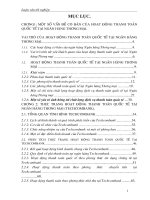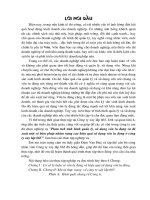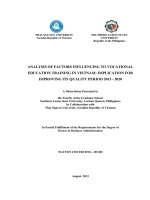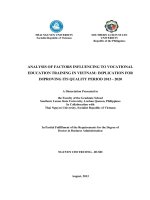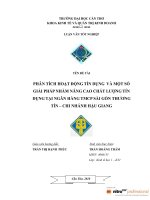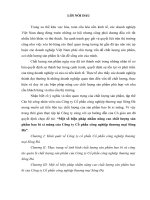phân tích các yếu tố ảnh hướng đến công tác dạy nghề việt nam một số giải pháp nhằm nâng cao chất lượng giai đoạn 2013 – 2020 ban tóm tắt tiếng anh
Bạn đang xem bản rút gọn của tài liệu. Xem và tải ngay bản đầy đủ của tài liệu tại đây (330.3 KB, 32 trang )
1
PREFACE
A high skilled workforce is an importance factor in terms of
increasing in productivities and strengthening nation’s
competitiveness. Strategy for development of human resources
period 2010 – 2020 which was approved by Government in 2010
with a solution is “comprehensive and basically innovation of
education, training as the social development needs; improving the
training quality as the requirements in terms of standardization,
modernization, socialization, demonization and international
integration to efficient server to the development of and defend
motherland”. In other hand, the Government’s guidelines at the
Strategy for Vocational Education Training (VET) periods 2011 -
2020 that was approved in 2011 also identified: “Improving quality
and increasing VET scale is a process to universalized VET and, in
other hand is to meet the demands for high skilled workforce for
industries needs in both of domestic and abroad working. Therefore,
improving quality of VET periods 2013 - 2020 is very importance.
Hence, this dissertation analyzed the factors influencing to quality of
VET in Vietnam and recommend some resolutions to improve VET
quality in Vietnam periods 2013 – 2020, in which consider and
review any efficient models and good lesson learnts or experiences
from foreigners countries with advanced VET. The dissertation
including 5 chapters are as follows:
CHAPTER I
INTRODUCTION
Background of the Study
At present, new technology in almost industries has been
changing very fast. New technology in some industries like
Information computer technology, electronics, mechatronics,
manufactory automation etc. are changing so quickly in every years,
2
even under one year. In this process, there are necessarily to request
for upgrading the skilled workforce including existing skills areas
and new skills areas occurred to meet the demands for socio-
economic development in the new era. This will challenge the
Vietnamese Vocational Education Training (VET) for how can be
flexibility changing in terms of industry needs. In order to solve those
problems, VET should be improved and strengthened training
capacity to meet the requirements of high skilled human resources in
the new context, especially should have the VET policies, strategies,
plans and curricular, training programs that are advanced enough,
scientific, suitable and fit with existing industries needs.
From International experiences, in order to have a flexibility
VET system, United Kingdom has the Sector Skills Councils (SSCs);
Australia has the Industry Skills Councils (ISCs). In two these
countries, model of SSC or ISC play as midle to connect between
industry, VET and government. In Japan and Korea, they develop the
testing and certification system separately between training side
(VET) to supply skilled labor for labor market. This model also has
strong engagement of industry to Vocational Education Training. In
Vietnam, in 2008 ministry of Labor, Invalids and Social Affairs
(MoLISA) has introduced a new frame work to develop a National
Occupational Skills Standards (NOSS) under Decision No.
09/2008/QĐ-BLĐTBXH dated 28
th
March 2008 regulate the
principles and procedures for development and issuance of NOSS.
Under this framework, the ministries will develop the national
occupational skills standards for each occupational which under
ministry’s management and collaboration for approval and issuance
of NOSS by MoLISA.
The advantages of the NOSS is a foundation for: General
Directorate of Vocational training (GDVT) is an agency that is
authorized by MoLISA to manage the development of NOSS to
manage the national skills testing and certification systems and help
MoLISA to issue other related policies in terms of skilled workforce
3
development; for VET institutes to develop the curricular and
training program; for employers to develop the employee
recruitment, wage payment plans and to identify the training needs
and arrange working position for employees; for the labourers to
identify these skills gaps and improve for themselves to seek for the
job. However, NOSS only has real its value as above mentioned
advantages, the procedure and process to develop NOSS should be
strongly engaged by industries. In other hand, industries must be
involved to identity the skills needs for each skill area as these
requirements for manufacture, and those skills will be developed
skills standards for training side to train the right skills and right
skilled levels for right needs of industry side. Unfortunately, there are
still miss of participation of industries side in this process, therefore
NOSS really is not useful any more as government expectation and
socials needs in terms of human resources development, especially in
training program or curricular development to fit with social needs.
On May 2012, Vietnam government has approved and issued
two importance national strategies: strategy for development of
education stage 2011- 2020 and strategy for development of
Vocational Education Training stage 2011 – 2020. Two above
strategies have the objectives that are towards to the solutions of
“comprehensive and basically innovation of education, training as the
social development needs; improving the training quality as the
requirements in terms of standardization, modernization,
socialization, demonization and international integration to efficient
server to the development of and defend motherland” that has been
approved by Government at the Strategy for human resources
development period 2010 - 2020 and contribute to the country
mission “will basically become a developed country by 2020”.
Therefore, this thesis would like to discuss on:
“Analysis of Vocational Education Training in Vietnam:
Implication for improving its quality period 2013-2020”
4
Statement of the Problem
To implement this study, the author answered the
following questions:
1. What is the profile of the respondents in terms of age,
gender, educational level, civil status and income?
2. What is the perception of respondent in terms of
individual characteristics, training quality, physical facilities,
management capacity, job opportunities, information on labor
market, support policies?
3. What are the factors influencing to vocational
education training?
4. Problems of Vocational Education Training of
Vietnam and experiences from developed countries?
Objectives of the Study
The study aimed to evaluate status of vocational education
training in Viet Nam and determine factors that influencing to
quality of vocational education training.
Specifically, this study aimed:
1. To describe the profile of the respondents in terms of:
a) Age
b) Gender
c) Educational level
d) Marital status
e) Income
2. To analyze perception of learners in terms of:
a, Individual characteristics
b, Training quality
c, Physical facilities
d, Management capacity
e, Job opportunities
f, Information on labor market
g, Support policies
5
3. To determine factors influencing to quality of
vocational education training.
4. To analyze problem of VET in Vietnam
5. To recommends strategies for the improvement of
vocational education programs.
Significance of the study
In this year 2013, Vietnam government will submit to new
law of Vocational Education Training and new law of
Employment for National Assembly approval; Government has
approved the strategy for development of vocational education
training periods 2011 – 2020, in which nominated Ministry of
Labor – Invalid and Social Affairs to submit to Government for
approval of the project of “Basically and comprehensive
innovation of Vocational Education Training towards 2020” in
order to upgrade a skilled work force to meet the demands for
the development of industries. Therefore, this thesis might be
benefit for policy makers in vocational education training
sectors, skilled work force developers, Vocational Education
Training institutions, industry side and related researchers.
Scope and limitation of the study
The main purpose of a vocational education training system is
to produce the skilled workforce to meet the demand for industry
needs. This thesis will focus to study on lessons learned and
experiences in terms of what policies and models for industry
engagement in Vocational Education Training that is responsive to
the needs of industry and the emerging market economy.
The study assessed quality of vocational education training
in Vietnam in terms of the following major seven variables:
Individual characteristics, training quality, physical facilities,
management capacity, job opportunities, information on labor
market, support policies. These main variables were due to the
results of reviewing related literatures and studies. This paper
6
considered total provinces in Vietnam. However, this research
conduct surveys from two Vocational Education Training
institutions each province only. And within each institution,
only one manager, two staffs and two learners was interviewed.
This study conducted during the year 2012-2013.
CHAPTER II
REVIEW OF RELATED LITERATURE AND STUDIES
This section presents the basic concepts, the content related to
Vocational Education Training sorted by the variables studied.
Conceptual Framework
Research Framework describes briefly, how to define the
problem, to which the authors propose solutions to improve
Vocational Education Training based on the selected variables.
CHAPTER III
METHODOLOGY
Research Design
The study used a descriptive type of research that describes
the perception of learners in Vocational Education Training
Center in term of personal characteristic, teaching quality,
facilities, management capacity, job finding support, labor
market information, support policies.
Using quantitative analysis have some advantages: more
reliable and objective; can use statistics to generalize a finding;
often reduces and restructures a complex problem to a limited
number of variables; looks at relationships between variables and
can establish cause and effect in highly controlled
circumstances; tests theories or hypotheses; assumes sample is
7
representative of the population; subjectivity of researcher in
methodology is recognized less; less detailed than qualitative
data and may miss a desired response from the participant.
Research locale
The study assessed the status of vocational education
training in 63 provinces of Vietnam, under evaluation of two
biggest Vocational Education Training institutions each
province. The study was conducted during first of 2013.
Population and Sampling
Using Slovin’s formula to calculate the sample size.
2
*1 eN
N
n
Where:
n is size of the sample
N is total number of S employee
e is standard error at α = 0.05
Normally, we will use Slovin's formula to determine
samples. But in this case, population of data is too big, this
formula is no longer available; hence the author selects two
biggest Vocational Education Training each province and
chooses randomly employees. So, totally, we will interview and
evaluate 126 managers, 252 staffs and 252 learners.
Research Instrument
A self-constructed questionnaire will be used to get the
primary data. The questionnaire is composed of two parts.
Respondents’ profile
Perception of respondents about vocational
education training in term of individual characteristics, training
quality, physical facilities, management capacity, job
opportunities, information on labor market, support policies
8
Determination of factors influencing to quality of
vocational education training.
The questions were in the form of Likert - type scale using
the give point scale with five as the highest and one as the
lowest. It was assigned with the following values:
Table 1: Questionnaire’s point range
1
Point
Point Range
Descriptive Interpretation
5
4.20 – 5.00
Excellent
4
3.40 – 4.19
Good
3
2.60 – 3.39
Fair
2
1.80 – 2.59
Poor
1
1.00 – 1.79
Very Poor
Independent variables (individual characteristics, Lecturer
quality, physical facilities, management capacity, job
opportunities, information on labor market, support policies)
and dependent variable will be measured by a list of questions,
which was explain in questionnaires.
List of questions will be checked accordance by
Cronbach’s Alpha. Cronbach’s Alpha from 0.8 to near 1, the
measurement scale as well, from 0.7 to 0.8 is used. The
researchers also suggest that the Cronbach’s Alpha of 0.6 or
more can be use in the event of working on new concepts or
new for respondent in the context of the study (Chu Hoang
Trong, Nguyen Mong Ngoc, 2005). So for this study, the
Cronbach Alpha of 0.6 or more is acceptable.
Data Gathering Procedure
Some government agencies were visited to gather
information needed. These agencies were the National Statistics
Office and Ministry of Planning and Investment which
1
Table number in this summery is same as the table number in the
Dissertation
9
provided them information about labor market. Different
schools and libraries were also visited to gather theories and
concepts from books and other research materials and
necessary data about competitiveness. Websites were also
visited to gather additional data regarding the subject matter.
The researcher then prepared the questionnaire using the
Likert-type scale with five points. It was afterwards checked by
the adviser. Questionnaires were sent to 10 learners. Next, they
modified it and were given to some faculty experts for the
validation of its contents. After that, it was given to the panel of
examiners for the approval. After the approval, the research
conducted a dry-run to test the reliability of the questionnaire.
The statistician using Statistical Package for Social Sciences
(SPSS) software program checked the reliability of the
questionnaire. After the reliability was proven, the researcher
conducted the actual survey.
The researcher distributed the questionnaires to the
respondents 630 learners within 63 provinces. Then, the
questionnaires were retrieved. The results were tallied, tabulate
and treated statistically. Finally, the results were interpreted and
the findings and conclusions were drawn.
Statistical treatment
Descriptive Statistics - Mean, standard deviation, Rank,
Percent, Frequency to describe the profile of the respondents in
terms of age, gender, civil status, educational level and income;
to describe perception of learners at Vocational Education
Training center.
Correlation and regression analysis was used to
determine factors influencing to quality of vocational education
training.
10
The multivariate regression equation:
VT = B
0
+ B
1
*IE + B
2
*QT + B
3
*PF + B
4
*AM + B
5
*SP +
B
6
*IL + B
7
*SU + e
Where:
IE = Individual characteristics
QT = Training quality
PF = Physical facilities
AM = Management capacity
SP = Job opportunities
IL = Information on labor market
SU = Support policies
VT = Vocational Education training
e = Random error
Independent variable will be: (1) Individual characteristics,
(2) Training quality, (3) Physical facilities, (4) Management
capacity, (5) Job opportunities, (6) Information on labor market,
(7) Support policies.
CHAPTER IV
RESULTS AND DISCUSSION
This chapter presents the analysis and interpretation of data
based from the sub-problems presented in the study.
Profile of respondents
Table 2 is presented below was describe the demographic
information of the answer objects related to research, based on
frequency and percentage value. The demographic variables
used in the study include: gender, age, education level, marital
status and income.
11
Table 2: Demographic information of the respondents
Profile
Frequency
Percentage (%)
Manager
Staff
Learner
Manager
Staff
Learner
A. Age
18-25
0
6
128
0
0.95
20.30
26-35
0
38
109
0
6.02
17.32
36-45
49
121
15
7.78
19.22
2.38
>45
77
87
0
12.22
13.81
0
Total
126
252
252
20
40
40
B. Gender
Male
76
165
220
12.06
26.19
34.92
Female
50
87
32
7.94
13.81
5.08
Total
126
252
252
20
40
40
C. Marital
status
Unmarried
7
41
217
1.11
6.51
34.44
Married
119
211
35
18.89
33.49
5.56
Total
126
252
252
20
40
40
D. Income
No income
0
1
239
0
0.16
37.94
< 1.5 million
VND
0
31
12
0
4.92
1.90
> 1.5 million
VND
126
220
1
20
34.92
0.16
Total
126
252
252
20
40
40
E. Educational
level
High school
0
0
28
0
0
4.45
Vocational
school
9
6
219
1.43
0.95
34.76
University,
college
117
246
5
18.57
39.05
0.79
Total
126
252
252
20
40
40
The above table shows that, the distribution by gender
sample of 630 subjects responded with the corresponding ratio
is 73.17% male and 26.83% female. In which, male are learners
accounted for the highest number with 220 people (34.92%
proportion) and female include 32 people are learners (5.08%
12
proportion). Managers include 126 people, 76 female and 50
male, with ratio 12.06% and 7.94%. Staffs are male and female
with nearly equal proportion (26.19% proportion are male and
13.81% proportion are female).
Most of respondent have age 36-45 years old (29.38%
proportion) in which 15 people are learners (2.38% proportion),
121 people are staffs (19.22% proportion) and 49 people are
managers (7.78% proportion). Followed by over 45 year-old
age group with 164 people (26.03% proportion). Next, 26-35
year-old age group are 147 people and the end 134 people in
18-25 year-old age group.
Structure by marital status: 265 people in 630 participants
interviewed are unmarried with percentage of 42.06%, in which
41 people are staffs (6.51% proportion) and 217 people are
learners (34.44% proportion), 7 people are managers (7.11%
proportion). There are 365 married people with percentage of
57.94% (include 5.56% are learners, 33.49% are staffs and
18.89% are managers). This is entirely consistent due to the
number of participants interviewed in the over 36 years old
group with percentage are high rate
Most of the respondents have income > 2.5 million
VND/month include 347 people (55.08%) and most of them are
staffs and managers, follow respondents have no income,
include 239 people are learners (37.94% proportion) and 0.16%
proportion is staff. The end people have income <1.5 million
VND/month are 6.82% include 1.90% people are learners and
31 people are staffs (4.92% proportion). Actually, respondent
mostly are learners and staffs. The learners want to study
technical skills or other skills to finding job.
The respondents by education level, majority they have
university or college degree (58.41%), all of them are staffs and
managers, vocational school corresponds to a rate of 37.14%
13
and only 4.45% are high school, in which 28 people are
learners. That is right because most of respondents are staffs,
they have high education level.
Respondents’ perception on Vocational Education Training
Based on the theory of researchers to build models and
develop research hypotheses. Quantitative research was used to
test the hypothesis for research methods, with technical surveys
collected opinions through the questionnaire with the sample
set size n = 630. I used Cronbach's Alpha to test the reliability
of the questionnaire. Model and research hypotheses are tested
through correlation analysis and Multiple Linear Regression.
The research results show:
After, I used Cronbach's Alpha to test the reliability of the
questionnaire and don't remove variables.
Through regression analysis results, I concluded: 7
factors: Individual characteristics, qualifications of lectures,
physical facilities, Management capacity, job opportunities,
information on labor market, Support policies effecting
Vocational Education Training.
Table 23: Average evaluation
Factors
Manager
Staff
Learner
WM
Descriptive
Interpret.
WM
Descriptive
Interpret.
WM
Descriptive
Interpret.
Individual characteristics
3.7
Good
3.6
Good
3.4
Good
Lecturer quality
3.8
Good
3.0
Fair
3.3
Fair
Physical facilities
3.1
Fair
2.4
Poor
2.1
Poor
Ability to mange
3.9
Good
3.1
Fair
2.8
Fair
Job opportunities
3.0
Fair
2.9
Fair
2.5
Poor
Information on labor market
3.2
Fair
3.0
Fair
2.6
Fair
Support policies on Vocational
Education Training
4.2
Excellent
4.1
Good
3.9
Good
Average WM
3.6
Good
3.2
Fair
2.9
Fair
14
According to above table, “support policies on Vocational
Education Training” from government and Vocational
Education Training institution were rated “good” by all
respondent groups. Learner group show good attitude and
ambition and attend class fully. However, lecturer quality is
normal, need improvement. Physical facilities of Vocational
Education Training institution are very bad, old and out-of-date
and need upgrading. Management capacity of Vocational
Education Training institution is medium. Job opportunities is
poor, information on labor market was rated “fair” and
inadequate. Overall, vocational education training faces lots of
problem and need focused solutions.
Factors affecting quality of Vocational Education Training
Regression analysis will be carried out with 7
independent variables Individual characteristics,
qualification of lectures, physical facilities, Management
capacity, support and job manage, information on labor
market, support policies on Vocational Education Training,
one dependent variable is Vocational Education Training.
Table 27: Result of linear regression analysis after were
excluded variable
Model
Coefficients
Sig.
Collinearity Statistics
B
Std. Error
Tolerance
VIF
1
(Constant)
.436
1.306
.808
IE
.164
.205
.031
.463
1.747
QT
.212
.211
.029
.536
1.636
PF
.486
.296
.007
.632
2.189
AM
.295
.260
.023
.736
1.455
SP
.312
.282
.009
.262
3.646
IL
.301
.272
.012
.494
2.735
SU
.120
.199
.048
.573
1.574
15
Looking at the result table of linear regression analysis
after were excluded variable, we saw Variance inflation factor
(VIF) of each variable that were less than 10, so
multicollinearity phenomenon does not affect the model
interpretation results. The rules are when VIF exceeded 10, it
has signs of multicollinearity phenomenon.
Linear regression equation takes the following form
VT =
0.486*PF+0.312*SP+0.310*IL+0.295*AM+0.212*QT+0.164
*IE+0.120*SM
The regression results show that the independent variables
PF, SP, IL, AM, QT, IE, SM have Sig smaller than 0.05 so the
variables are significant at 95%. So at 95% confidence level,
the independent variable affects the dependent variable and the
slope coefficients are respectively 0.486, 0.312, 0.310, 0.295,
0.212, 0.164, 0.120. The variables of PF, SP, IL, AM, QT, IE,
SM are positive so all variables affect the same direction of the
Vocational Education Training variable is negative affecting
reverse with Vocational Education Training.
The importance of PF, SP, IL, AM, QT, IE, SM for
Vocational Education Training variables are determined based
on Beta coefficient. If the bigger the absolute value of Beta
coefficient of each factor is, the respondent more important that
factor affect the Vocational Education Training. Therefore, the
most important factor affecting to Vocational Education
Training is PF (Beta = 0.486), followed by SP factor (Beta =
0.312), followed by IL factor (Beta = 0.310), AM factor (Beta
= 0.295), QT factor (Beta = 0.212), IE factor (Beta = 0.164),
and finally SM factor (Beta = 0.120).
16
In short, basing on the regression results there are 7
factors that affect Vocational Education Training.
Particularly, PF factor has the greatest impact on Vocational
Education Training (for the largest Beta coefficient), and
SM factor has the least effect.
Comparison of respondents’ perception according to related
profile
Comparison between the respondent’s perceptions are
explained details in below tables:
Table 38: Comparison between the respondents’ perception
when they are grouped following related profile
Indicator
Age
Gender
Marital
status
Income
Educational
level
IE
.001
Reject Null
.120
Accept Null
.338
Accept Null
.110
Accept Null
.552
Accept Null
QT
.022
Reject Null
.547
Accept Null
.057
Accept Null
.129
Accept Null
.160
Accept Null
PF
.001
Reject Null
.066
Accept Null
.658
Accept Null
.446
Accept Null
.205
Accept Null
AM
.009
Reject Null
.220
Accept Null
.233
Accept Null
.240
Accept Null
.546
Accept Null
SP
.004
Reject Null
.419
Accept Null
.532
Accept Null
.351
Accept Null
.162
Accept Null
IL
.021
Reject Null
.447
Accept Null
.006
Reject Null
.624
Accept Null
.136
Accept Null
SU
.101
Accept
Null
.703
Accept Null
.232
Accept Null
.761
Accept Null
.152
Accept Null
VT
.033
Reject Null
.180
Accept Null
.291
Accept Null
.114
Accept Null
.091
Accept Null
17
The result of research show that: with age factor, the sig
coefficients of variables are less than 0.05, this indicates that
there are significant differences between the respondents’
perception on on Individual characteristics, qualification of
lectures, physical facilities, Management capacity, job
opportunities, information on labor market and Vocational
Education Training with age. And Support policies factor has
Sig=0.101>0.05, shows that there isn't significant differences
between the respondents’ perception on Support policies and age.
About Gender, the sig coefficients of variables are greater than
0.05, this indicates that there are significant same between the
respondents’ perception according to related profile with gender
About marital status, information on labor market factor
has Sig=.006<.05, shows that there is significant differences
between the respondents’ perception on information on labor
market and marital status. The remaining variables have the sig
coefficients of variables are greater than 0.05, this indicates that
there aren’t significant differences with marital status
About income, the sig coefficients of variables are greater
than 0.05, this indicates that there are significant same between the
respondents’ perception according to related profile with income
About educational level, the sig coefficients of variables
are greater than 0.05, there are not significant differences
between the respondents’ perception Individual characteristics,
qualification of lectures, physical facilities, Management
capacity, job opportunities, information on labor market,
support policies and Vocational Education Training with
educational level.
18
VET in Vietnam
Challenges on the VET in Vietnam is as follows. First, the
enrollment rate of the lower secondary vocational education
under MOET is very high and competitive, but most of the
graduates enter the college or university. Considering that there
is a lack of cooperation for MOET with the enterprises due to
the lack of financial budget in vocational education, it is
necessary to collaborate with the enterprises more closely. Also,
the issue in merging two courses should be examined because
VET courses of MOET and MOLISA have almost no
difference when comparing from education contents, period
and facility perspectives.
Second, the biggest challenge in Vietnamese VET lies on
the absence of cooperation between industries and educational
sectors. First of all, industries have no interest or participation
in VET. Thus, the results of VET cannot satisfy the demand of
industries. Therefore, it can be said that VET is not driven by
consumers (industry) but by suppliers. In order to resolve this
kind of matter, government should make a policy for evoking
interests of industries to VET.
Thirdly, another matter is about the awareness of the VET
among the enterprises. Enterprises prefer the academic
education including university diploma and regard VET as the
second-class training. Therefore, an aggressive VET marketing
strategy (P.R. & Advertising) is necessary in order to resolve
this recognition problem.
Lastly, there is a matter of professionalism on the teachers at
the training centers. Because the training institutes cannot
accommodate the teachers with practical ability due to low wage
of teachers, the matter of how to raise the competency of teachers
with lacking experience and ability remains a critical task.
19
Evaluating development of National Occupational Skills
Standards and partnership of VET and enterprise in
Vietnam
National Occupational Skills Standards
Until this time of 2013, Vietnam has developed 148 NOSS,
among which MOLISA finally approved 126 NOSS (refer to
Table 40). Because schools mainly developed NOSS by using
Dacum method while lacking participation of enterprises in
NOSS development process, the actuality of developed NOSS
is not guaranteed. The reasons why enterprises not participating
in NOSS development include not only occupied field experts
but excessively low incentive (e.g. expert allowance) that
cannot attract the participation of these experts. In other hand,
NOSS requires a forced regulation for equipping continuous
actuality through periodical revision, but currently there is no
such regulation in law.
Certification System
Since Circular No. 15/2011/TT-BLDTBXH has issued by
MoLISA in 2011 about management of evaluating and
certificating national occupational skills for the labourer,
Vietnam has been established 16 Skills Testing Centers and
certificated national occupational skills for 897 labourers in
nationwide (Aug. 2013 – reference to GDVT).
The overall problems of Vietnamese Certification System
can be summarized as 5 items in the below. Firstly, with the
lack of public relation for the necessity of acquiring certificate,
enterprises and public have insufficient recognition on the
importance of certificate.
20
Secondly, because there is no preferential treatment policy
for certificate acquisition, legislating a new law for giving
preferential treatment to certificate holder is required.
Thirdly, in relation to testing implementation, related
personnel are lacking their expertise. Since there are no
executive members or assessment members equipped with
expertise, they face difficulties in systemizing levels making
criteria and testing execution.
Fourthly, the problem that can be identified through the
result of “2011 Trial Test” is expense related issue. Currently
NOSS is used directly as the standard of question making for test
without being used first as the training standard in training
course. Without having a training course based on NOSS, the
testing based only on NOSS can bring the expensive testing.
Especially, as we can seen in “2011 Trial Test”, the testing
method is skill demonstrating type and thus, not many examinee
can take the test at the same time but have to take tests in several
sequences. Therefore, testing time can be prolonged and testing
will be expensive because of many required equipments.
Practicing this kind of testing method in Vietnamese
environment has many limitations. Therefore, it is required to
introduce the low cost certification testing system in Vietnam.
Fifthly, it is necessary to improve the testing method.
Vietnamese practical skills test is not like diverse methods of
Korean counterpart and limited as skill demonstration, requiring
much time and cost. Also introducing diverse testing methods (e.g.
write-out, and interview) that can replace the practical test in the
cases of lacking testing equipments is necessary.
21
Lastly, once developed NOSS is directly linked to one
certification. Therefore, the job range of one certification is
substantially wide and that results wide range of test too.
Therefore, the range of job should be limited to the employment
capacity unit. In order to do that, more segmented certifications
should be made when making certification with NOSS.
NOSS, Certification system and engagement of industries
in VET
According to decision no. 09/2008/QD-BLDTBXH, the
following purposes of the NOSS are involved with solving the
mismatch problem between the skills required by the enterprises
and the skills provided by the VET system in Vietnam.
According to a standardized framework, to certify the
labourers in Vietnam is the main reason for developing the
NOSS by GDVT and MOLISA. To meet the requirements of the
employers by defining and assessing the requirements of
essential theoretical knowledge, practical skills and attitudes of
all the occupations and to make the skills of the labourers in
Vietnam comparable are the core functions of the NOSS (see
Decision 09/2008/QD-BLDTBXH, p.2f). The employers should
have a standardized basis to recruit employees and to assign
reasonable wages for employees. The employees should be
enabled to improve their knowledge and skills achieve to the
defined standards. Therefore, the standards could be seen as a
quality ensuring instrument of the workforce in Vietnam (see the
Law on Vocational Education Training 2006, article 79, p.24).
Legal system and regulations
There is no separate law approved by the National
Assembly that regulates National Skills Testing Certification
System (NSTCS) in Vietnam. At present, the law that regulates


